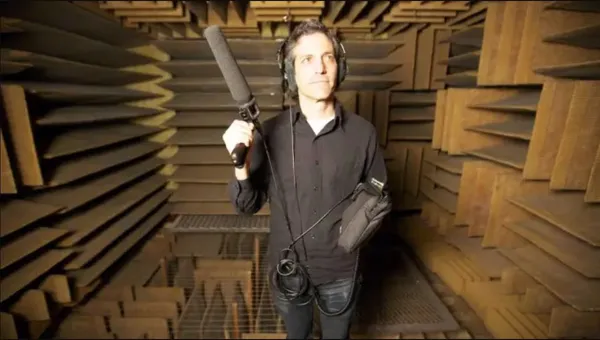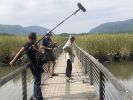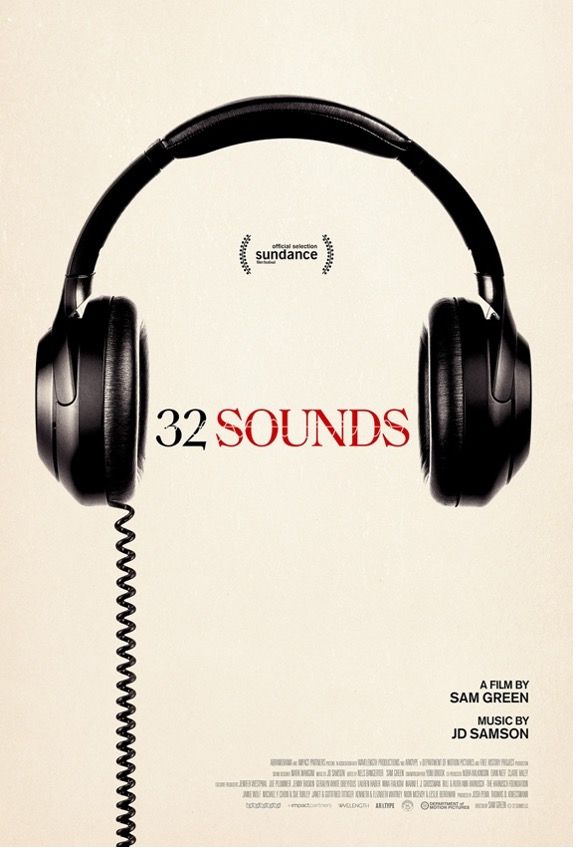Eye For Film >> Movies >> 32 Sounds (2022) Film Review
32 Sounds
Reviewed by: Jennie Kermode

When talking about cinema, people often discuss the actors they like to watch, or directors whose output they admire. Sometimes they’ll go on to discuss the look of a film, or its score. it’s very rare, however, for anyone to talk about the sound design. Where would we be without sound? Partway through Sam Green’s documentary we take a brief trip back in time to the early days of cinema, even before it was accompanied by pianos or orchestras. It shows us what it was like watching early talkies when all the sound came from a central speaker, and explains how Alan Blumlein invented stereo sound in response. This is the immersive cinema we know today. The rest of this film invites us to think about how it’s put together and how sound, and the recording of sound, shape our lives more widely.
You will need a good sound system to fully appreciate this film, but don’t feel that this means you have to be in a cinema, or that you need to be all alone in a quiet house wearing good headphones. 32 Sounds has been crafted to work in different ways in different settings. Viewers will experience it differently, even if they have perfect hearing. If your hearing is impaired, you may still find it intriguing if you watch in a setting which lets you feel some of the sound. Green is alert to all these different relationships with sound, which matters all the more because this is an audience participation film. Small tasks are set for viewers which, if you can carry them out, will enhance your experience in still more interesting ways.

The whole thing begins with sound as heard in the womb. There’s a quote from Walter Murch about sound being the first of our senses to develop, after just four months of gestation – our first real connection to the external world. For the director, though, the film started with Annea Lockwood, who appears to talk about her many decades of recording river sounds. She’s one of several fascinating speakers who discuss their experiences here, often in starkly personal terms. Their accounts are separated by montages of sound and vision. Glenn Gould playing piano, someone typing, crackling fires, crunching snow, people beating up an old piano, dry leaves, a purring cat, a whoopee cushion. A tree falling in the forest and no-one is there to hear it. Later we will see the tree again, with added sound.
Sound means life. There is reflection on the sensation which people described after listening to the first phonograph recordings – a suggestion that, by preserving the voices of those who were gone, they might defeat death. Old voicemail messages from lost loved ones retain a profound impact today. A physicist has a strange encounter with a tape recorded by his 11-year-old self, who seems now like a separate person, speaking to him from another world. “Even though you exist in a different time, I am talking to you through this machine,” says the boy, stating that he hopes he has made their dreams come true.
Do we understand time differently due to our power to preserve sound? Has this experience deepened our awareness of its passage and loss, our ability to appreciate the ephemeral beauty of the present moment? We visit an audio library to hear the saddest sound in the world. We reflect on shared experiences, bound together by music, and what it means when the other person who knew the secret, personal meaning of a song is gone. But there is also playfulness. In New York City we meet a man who is famous for driving around the streets late at night blasting Phil Collins’ In The Air Tonight out of his jacked-up car stereo. We watch a Foley artist at work, using a wet rag to create the sounds of someone being stabbed, bleeding out or having sex. Green talks about how good it can feel to make sound, inviting viewers to give it a go right there and then. There is a five minute dance interlude with the Communards’ version of I Feel Love and images of people from different cultures and times dancing their hearts out.
There is, as you would expect, technical discussion of sound work, of how to go about creating the feel of a film, of the strange new language which has developed whereby the sounds we expect onscreen are not actually realistic – cinema has taught us how to listen with our imaginations first, and only then our ears. A Deaf sound artist explains that Deaf people have to know the rules of sound, such as when to consciously turn off one’s voice. She sees sound as a social currency. There is reflection on the rapidly changing state of sound technology, and some fun with binaural sound, though you will only be able to fully appreciate that part with the aid of headphones.
The great mathematician Charles Babbage, represented here by half of his brain in a jar, wondered what happened to old sounds, theorising that with the right receiver, we could recover them – all the voices of the dead, like pieces of the souls of everyone who ever spoke or cried out. As the film winds down, Lockwood sits listening to the emergent noises of evening. If you listen closely to what this film has to say, you won’t listen to the world the same way afterwards. It has its strong moments and its weaker ones, not all of its experiments successful, but like the very best documentaries, it will leave you with a great deal to wonder at.
Reviewed on: 27 Apr 2023
















